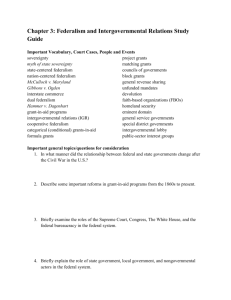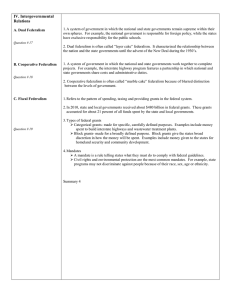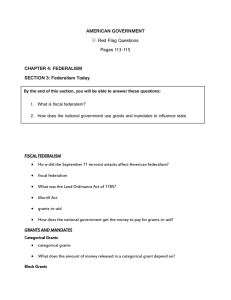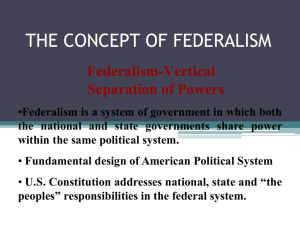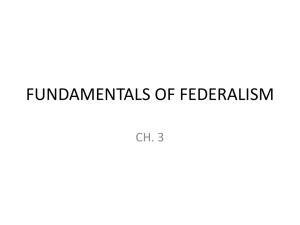PLS 308 – Public Administration Topic: Intergovernmental Relations (IGR)
advertisement
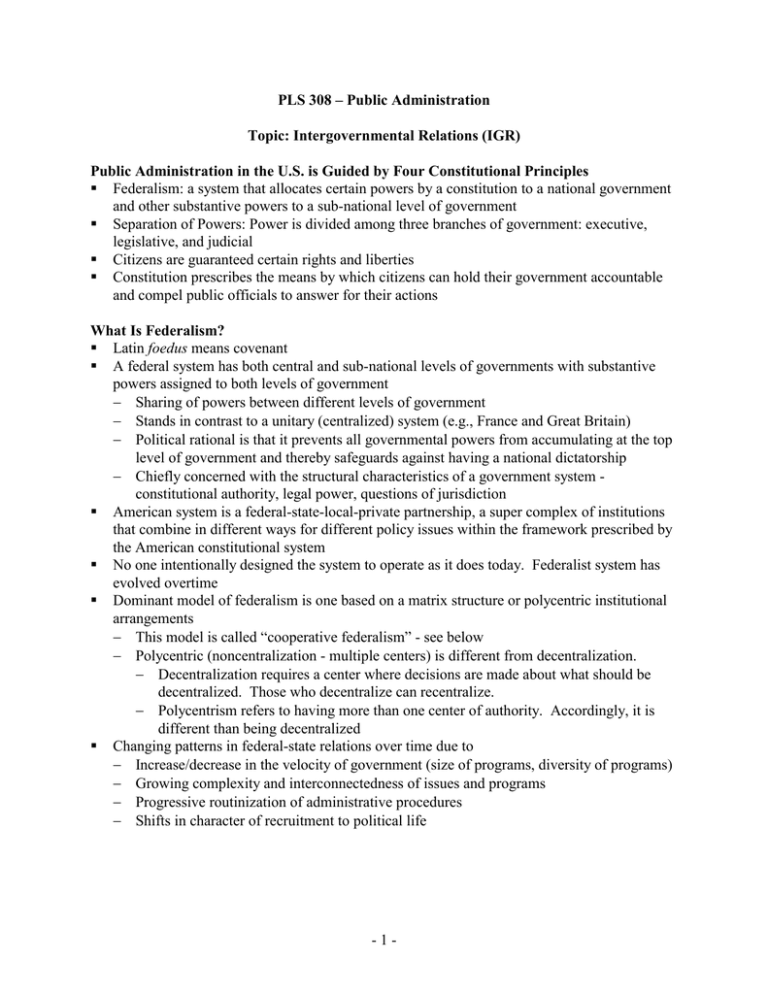
PLS 308 – Public Administration Topic: Intergovernmental Relations (IGR) Public Administration in the U.S. is Guided by Four Constitutional Principles ! Federalism: a system that allocates certain powers by a constitution to a national government and other substantive powers to a sub-national level of government ! Separation of Powers: Power is divided among three branches of government: executive, legislative, and judicial ! Citizens are guaranteed certain rights and liberties ! Constitution prescribes the means by which citizens can hold their government accountable and compel public officials to answer for their actions What Is Federalism? ! Latin foedus means covenant ! A federal system has both central and sub-national levels of governments with substantive powers assigned to both levels of government − Sharing of powers between different levels of government − Stands in contrast to a unitary (centralized) system (e.g., France and Great Britain) − Political rational is that it prevents all governmental powers from accumulating at the top level of government and thereby safeguards against having a national dictatorship − Chiefly concerned with the structural characteristics of a government system constitutional authority, legal power, questions of jurisdiction ! American system is a federal-state-local-private partnership, a super complex of institutions that combine in different ways for different policy issues within the framework prescribed by the American constitutional system ! No one intentionally designed the system to operate as it does today. Federalist system has evolved overtime ! Dominant model of federalism is one based on a matrix structure or polycentric institutional arrangements − This model is called “cooperative federalism” - see below − Polycentric (noncentralization - multiple centers) is different from decentralization. − Decentralization requires a center where decisions are made about what should be decentralized. Those who decentralize can recentralize. − Polycentrism refers to having more than one center of authority. Accordingly, it is different than being decentralized ! Changing patterns in federal-state relations over time due to − Increase/decrease in the velocity of government (size of programs, diversity of programs) − Growing complexity and interconnectedness of issues and programs − Progressive routinization of administrative procedures − Shifts in character of recruitment to political life -1- PLS 308 – Public Administration Lecture Notes - Imperial Federalism Models ! Dual Federalism Model − Functions and responsibilities of federal & state governments are separate and distinct (Layer cake model) − A system for dividing authority between federal and state governments that left considerable autonomy to each jurisdiction − Wasn’t until the “New Deal” that the idea takes hold that federal & state governments were complementary parts of a single mechanism for coping with problems − However, the underlying philosophical concept remained for some time ! Cooperative Federalism Model − Through the 1950s, cooperative federalism provided an excellent description of federal state relations − Perpetual tension in the search for a balance between the centers of power − This model enabled federalism to survive the growing period of federal-state interdependence − During the 1960s, the model begins to give way to other models (creative federalism, new federalism, picket fence federalism, etc.) − “Cooperative” does not imply that intergovernmental relations are always peaceful and friendly − “Antagonistic cooperation”; work together but not always willingly or in a friendly spirit and may perceive different and contradictory goals − Cooperation is negotiated. If not negotiated, cooperation is either coercive or antagonistic. Accordingly, this concept incorporates many of the forms of competition noted in competitive federalism − Many examples where the federal and state governments cooperate in regulating sectors of the economy where Congress has not preempted state authority (e.g., transportation, banking, consumer product safety, highway safety, the environment) Changing Patterns of Federalism ! Era of Dual Federalism (1789 - 1933) − Functions and responsibilities of federal & state governments are separate and distinct (Layer cake model) − Wasn’t until the “New Deal” that the idea takes hold that federal & state governments were complementary parts of a single mechanism for coping with problems ! Era of Cooperative Federalism (1933 - 1960) − National involvement in traditional local issues increases (e.g., unemployment insurance, economic development, etc.). − Role of federal government increases in importance. System begins to resemble more of a marble cake even though it appears to be structured as a layer cake. − System gets more centralized. Search for a balance of power between federal-state-localprivate begins − Important events shaping these trends − Depression: public pressure to protect individuals from economic catastrophes. This led to building new national institutions (e.g., Social Security Act, Welfare, etc.) -2- PLS 308 – Public Administration ! ! Lecture Notes - Imperial − Post-W.W.II: Worldwide expansion of responsibilities. Economic boom provides money for government expansion. − Perception that states were performing badly. States were overtly racist and defiant of federal desegregation efforts. This led to strengthening existing institutions. − State’s governance infrastructure was weak. Governors had few powers, small staffs, departments poorly organized. Legislatures were part time, unprofessional staffs, rural areas tended to dominate. Local governments equally bad. Era of Creative Federalism (1960 - 1968) − Some argue that just a continued refinement of cooperative federalism concept − Period of extensive growth in federal aid to state and local governments − Assertion of federal authority (e.g., Civil Rights Act) − “Great Society” programs (e.g., Model Cities, Medicaid) − Proliferation of grants and revenue sharing − Important turning point in federal-state-local relations − Federal government had a far more significant presence in the daily lives of state & local administrators − Intergovernmental system became much more difficult to manage − State & local officials became very dependent on federal $ − Matching component required state & local governments to put up money − Many grants went directly to agencies/programs. Governors and mayors less power Era of New Federalism (1968 - Present?) − The Nixon Administration proposed a series of initiatives: − Revenue sharing − Increased use of block grants − Administrative reforms to expedite and simplify the grant application and review process − Somewhat interrupted during Carter Administration − Reagan Administration was perhaps the most systematic and perhaps most sustained effort to remake the federal system since the New Deal. Reagan strongly believed in a more limited role for the national government and proposed: − An additional series of block grants − A dramatic simplification of intergovernmental aid − A devolution of responsibilities for many policies from the national to the state/local level − Administrative simplification such as reducing red tape and the burden of federal mandates − Revenue sharing was pulled in 1986 for budgetary reasons − Reagan’s efforts were challenged by many and many of the more ambitious proposals were ultimately set aside in favor of more block grants − Some argue that this is just a continued refinement of cooperative federalism concepts. Others say it represents centralized federalism − Disrupted old patterns, but did not fundamentally change them. For example, President Reagan’s commitment to reducing size and scope of federal government didn’t result in any real reduction in the size of government -3- PLS 308 – Public Administration Lecture Notes - Imperial − Central themes during this recent period are: − Decentralization and defunding. − Shifting more responsibility to the states. Based on the premise that states could implement many programs more effectively and responsibly. − Increased use of mandates – state and local governments increasingly are asked to do more with less Intergovernmental Relations (IGR) ! Important body of activities and interactions occurring between governmental units of all types and levels within the federal system − Concerned with the number and variety of government units − Number and diversity of different types of public officials − Intensity and regularity of contacts and interactions among officials − Importance of officials’ attitudes and actions − Preoccupation with financial policy issues ! More concerned with process: functional, fiscal, and administrative ! No one intentionally designed the intergovernmental system to operate as it does today. It continues to evolve Summary of Trends in Federal-State Relations ! Administrative discretion of federal agencies has been reduced ! Rise of administrative presidency − Nixon impounds agency funds - Congress takes away this authority − Use of political appointments to affect agency policy and direction increases − Decreased influence of senior career officials − Executive orders increasingly used to circumvent Congress ! Growing congressional oversight of federal agencies − Placed new curbs on administrator’s discretion − Increasingly professionalized congressional staff − Creation of expert advisory institutions (e.g., CBO, OTA, GAO) ! Increased openness of the political system at all levels − Sunshine laws − Public participation requirements − Facilitated citizen’s group challenges (e.g., CWA and CAA) − Intrusion of outside groups in agency affairs − Media has played a growing role − Local media can better inform constituents − State legislatures are more responsive to constituents ! Political environment of average agency is considerably less supportive and more adversarial ! Less money & more responsibility at the state level − Increased use of federal mandates − Direct orders to comply with certain rules − Conditions to receive federal aid − Adds confusion about who is in charge -4- PLS 308 – Public Administration ! Lecture Notes - Imperial − In some cases, the federal government has given states more flexibility to tailor programs to their unique circumstances − Examples would include waivers for programs that don’t meet strict federal guidelines Increased intergovernmental lobbying How States Responded to the Challenge of Increased Responsibilities ! Executive branch reforms − Longer terms − Development of professionalized staffs − Reduced numbers of independently elected officials ! Legislative branch reforms − Adopting new & sharply revised constitutions − Reapportionment − Professionalized staff ! Strengthened and diversified revenue systems − States have shown a great capacity to generate needed resources − Economic growth and new revenue sources (e.g., income taxes, lotteries, etc.) during the 1980s provided revenue for new initiatives − States expanded faster than federal and local levels ! Increased capacity of state & local agencies − Modernized institutions − Improved budgeting processes − Information management systems − Productivity measurement − Increased professionalism of staff − Expanded number and variety of administrative agencies responsible for addressing policy issues at the state level ! “States as Laboratories” − Key innovators (e.g., economic development, environment, growth management, education, health care, welfare reform, etc.) − Rising role for states in domestic policy − Lobbying to shape federal initiatives Fiscal Federalism ! Looks at the fiscal issues related to the operation of the federal system. Encompasses the flow of money among national, state, and local levels of government and the intergovernmental aspects of federal taxation − Examines where grant money flows and what the impacts are − How revenue and expenditure patterns change overtime − Looks at the impacts of fiscal policies (e.g., impacts of tax policies or distributive programs) − Why states choose different fiscal policies -5- PLS 308 – Public Administration ! Lecture Notes - Imperial The fiscal components of federal-state relations have undergone dramatic alterations during this century − Both federal and state governments have displaced local governments in the public finance of the United States − Federal government collects more than half of all public revenue and expends close to two-thirds of all government expenditures (difference is due to deficit spending) − Reason for federal dominance is 16 amendment to the constitution in 1913 which authorized the federal income tax − 1978 was the peak year in terms of the federal transfer of funds to state and local governments Grants ! Major feature of fiscal federalism is the grant-in-aid: A transfer of money from one government to another. − It is nearly always a conditional grant. Accordingly, one level of government attempts to influence the actions of another using a monetary award or the conditions attached to the award. − Volume of federal grants-in aid peaked in 1978. − Almost all grants are matched with nonfederal moneys ! Categorical vs. Block grants. − Categorical grants are highly specific and rather rigid and address narrow policy issues − The typical categorical grant has strings attached − There are three types of categorical grants − Formula grants are distributed by an administratively or legislatively based formula − Project grants or discretionary grants are distributed at the discretion of federal administrators (about 73% of categorical grants are project grants) − Formula/project grants are grants awarded at the discretion of federal administrators, but within the bounds of a formula such as the amount of money awarded per state − Block grants are formula grants which allow the recipient to exercise more discretion with respect to the way the federal funds are spent − Most are awarded to state governments, although some like the community development block grants are awarded directly to local governments − By awarding money to local governments, the federal government can exert more control over urban affairs (inner city redevelopment) (this is a more liberal oriented approach) − Political argument (often from conservatives) is to combine several categorical grants and place less restrictions on their use in order to provide state and local governments with more control − Until 1965, virtually all federal grants were categorical. Movement towards block grants is often a conservative argument that the state and local governments “know best” and it is a means of shifting control away from Washington and towards the states. Accordingly, liberals typically resist it. -6- PLS 308 – Public Administration Lecture Notes - Imperial ! General revenue sharing offers state and local governments the greatest level of discretion. Revenues were distributed to the states based on a formula with virtually no restrictions or stings attached − Program lasted between 1972 and 1986 and transferred $84 billion to state and local governments (about 14% of the total aid package) − Still present in a limited sense (e.g., mineral rights and grazing fees) which return some if the revenue to state and local governments ! Problems with grant system: − Numerous requirements often cause unintended difficulties − No clear way to coordinate the combined impact of grants − Difficulty in accounting for the outcomes and impacts of the grants Mandates ! Definition − A mandate is a federally imposed intergovernmental regulation that requires the government receiving a federal grant to advance specific social and national goals, or meet certain national standards, which may or may not pertain to the accompanying grant − May impose a financial sanction for noncompliance − May impose civil or criminal penalties − Reflects the tension between local autonomy (decentralization) and federal control (centralization) ! Mandates which are a tool which gives the federal government more control over state actions (e.g., it increases centralization). Come about as a result of legislative enactments and/or adoption of federal regulations. − One study found that nearly 1,300 federal regulations have been placed on state and local governments and the average number of regulations affecting these jurisdictions was 570 regulations per government − Number of intergovernmental regulations rose by 160% in the 1970s − Number of intergovernmental regulations represents a lager proportion of a shrinking legislative agenda − All of this was accompanied by much talk of deregulation ! At the federal level, mandates often take the form of: − Direct orders are an instruction from the federal government to state and local governments which, if not followed, can result in civil or criminal penalties (Equal Opportunity Act 1972 bans discrimination, 1977 CWA bans dumping of sewerage at sea) − Cross-cutting requirements are mandates that stipulate compliance with specific federal policies by all governments receiving federal grants. They are the most numerous and apply to virtually all federal financial assistance (e.g., comply with antidiscrimination statutes, NEPA, etc.) − Cross-over sanctions permit the federal government to punish a state by reducing or withdrawing federal aid in one or more programs if the standards are not being satisfied in a different program (e.g., cut highway funds if don’t enact minimum drinking age or pass motorcycle helmet laws) − Partial preemption Occurs when subnational governments are, in limited ways, denied their traditional prerogatives because the federal government demands that states adopt -7- PLS 308 – Public Administration ! ! ! Lecture Notes - Imperial and administer program standards set by Washington if the states want the federal aid (e.g., CAA and CWA). At the state level, mandates often take the form of: − Establishing the rules of the game: Setting rules for local elections, establishing limits on local government actions, designation of local officials − Spillovers or service: Spillover mandates relate to services (e.g., hospitals, health, education, welfare) that benefit persons outside of the local jurisdiction − Interlocal equity: Prevents local governments from engaging in activities that would harm their neighbors (e.g., environmental protection, land use, and tax assessment) − Loss of local tax base: State laws exempting property from local property taxes (e.g., university property, state buildings, etc.) or food or medicine from local sales taxes − Personnel mandates: Deals with pension benefits of local government employees, wages, personnel standards, working conditions Rationales for mandates − Federal or state government believes that the mandated activity is of such importance that discretion for engaging in the activity can not be left to state or local officials − The mandate could be justified on the grounds of achieving some desirable public purpose (e.g., clean water, equitable education for all students) − Federal or state officials may decide that uniformity in services (e.g., education) is essential − Tradition is often used to advance the argument for federal or state mandates when it doesn’t appear justified on other grounds − It is a way of saving federal or state governments money that they can use in other ways Governors and mayors have a valid complaint about the federal government -- it imposes costly rules and supplies no money to pay for them − Columbus Ohio study of complying with 14 environmental mandates would cost the city $1.6 Billion over 10 years -- $856 a year per family for 10 years − New unfunded mandate legislation makes it more difficult for Congress or a federal regulatory agency to impose costly requirements on state and local governments Intergovernmental Policy Implementation ! Most policy implementation is intergovernmental in nature − Numerous cases in which two or more organizations, sometimes even complex networks of organizations, are required to coordinate or cooperate to achieve policy success − Can be conceptualized as a problem of cooperation and coordination − Two broad reasons interorganizational action is often more difficult (O’Toole 1996) − Mechanisms for coordinating with an agencies may hinder interorganizational coordination − Forms of inducement to interunit cooperation are typically weaker than those available in simpler structures − Intergovernmental implementation can also create a variety of barriers to interagency collaboration do to “turf” (Bardach 1996) -8- PLS 308 – Public Administration ! ! ! Lecture Notes - Imperial Process of intergovernmental policy implementation in network settings is not well understood (O’Toole 1996) and neither is managing intergovernmental networks (Agranoff 1986, 1991; and Gage and Mandell 1990) − Early work focused on “iron triangles” linking interest groups, key congressmen and committee chairs, and career bureaucrats − Later research focuses on broader networks − Issue networks (Heclo 1978, See Stillman 2000, 447 - 456): a shared knowledge group having to do with some aspect of public policy. Most now use the term policy network. − Policy networks: Organizations focused on a particular policy area. Hard to know where one policy network ends and another begins. Focus of this research tends to be on policymaking rather than implementation. − Implementation structures: organizations (governmental and nongovernmental) involved in implementing a policy or program. Others use the term interorganizational network to describe the same phenomena. Collaboration research also focuses on similar phenomena. − Network and exchange models have been developed in recent years by social scientists, yet implementation researchers have not utilized this research to help improve their understanding of the implementation process (O’Toole 1996) O’Toole (1996) argues that interorganizational implementation cannot be treated as a pure instance of a self-forming network, nor as a strait forward case of principles and agents − Top-down approaches have minimized the self-forming nature of networks and see it as more of a principle agent problem − Bottom-up researchers also neglect that there is a principle-agent component and see implementation as essentially a problem of self-forming networks − Implementation contains elements of both (O’Toole 1996) Problems with interorganizational implementation (O’Toole 1996) − Uncertainty: participants lack knowledge of other actor’s true preferences. A large number of actions and the availability of different implementation strategies creates another source of uncertainty that can be difficult to model. In addition, someone else’s actions open up additional strategies for participants engaged in bargaining. Complicated structure of the network and the connectedness of interactions may introduce additional uncertainties. Accordingly, it becomes a problem of nested games. − Problems of monitoring and enforcement − Current models can not provide much insight on what is expected to happen in interorganizational settings − Strategies that can be employed to improve interorganizational implementation − Managers can be active in initiating certain moves that don’t alter the structure of the strategic situation − Signaling preferences − Making commitments − Iteration or repeating actions in a predictable way − Managers can propose appropriate or potentially appropriate pareto-efficient equilibria (to use game-theoretic language) -9- PLS 308 – Public Administration Lecture Notes - Imperial − Managers can facilitate the play of strategic games when interests are closely aligned, but coordination is needed − Managers can use persuasion to influence preferences − Attempt to change interunit structure or relationships to try and increase or encourage cooperation Interorganizational Relations (Hall 1991) (IOR) ! Accumulated knowledge is highly fragmented and the scholarship is uneven (Hall 1991) ! Characteristics of the environment − A number of characteristics have been identified as being important for creating or sustaining IORs (Hall 1991) − Legal mandates may require them − Cultural conditions may support or repress IORs − Organizations in highly complex technological environments tend to know each other − As turbulence increases (interconnectedness of environmental factors), IORs are expected to increase − Heterogeneous environment would likely have a higher capacity for IORs − Complexity would tend to increase IORs − Still more work needs to be done. Some like environmental capacity are unclear. ! Situational factors. Five factors appear to be crucial for IORs (Hall 1991) − Awareness: Organizations vary in terms of their awareness of other organizations around them. Hierarchy of awareness − General awareness of other organizations − Mutual acquaintance among organizations − Specific and programmed interactions − Domain consensus-disensus: Two factors are important. − Consensus or disagreement on the domain. − Issue of ideological compatibility − Geographical proximity: Distribution of organizations in geographic space has been given little attention, but should be important − Localized independence: Degree to which organizations are dependent on the local area for their resources − Size: Size of the actual or potential network. − At any given time their are a finite number of organizations available for interaction − Larger the network, the weaker the quality of the relationships ! Reasons for interaction (Hall 1991) − Ad Hoc Bases: Little or no previous patterning in the relationship between organizations, but an unusual problem or circumstance may arise that creates a one-time need for cooperation − Exchange Bases: This has been the dominant focus of interactions. It involves any voluntary activity between organizations that has consequences, actual or anticipated, for the realization of their respective goals - 10 - PLS 308 – Public Administration ! ! Lecture Notes - Imperial − Formalized agreements: The degree to which the interdependency between organizations is officially recognized. It is typically written down and may be legally or contractually binding − Mandatedness: The extent to which relationships are governed by laws or regulations Resource flows (Hall 1991) − Resource interdependence: A situation in which two or more organizations are dependent upon one another for the resources each has access to or control. Three forms of interdependence − Horizontal: A members of an organization set compete with each other in obtaining resources and disposing of goods and services − Vertical: Interact at different stages of the production of goods and services (e.g., police, courts, probation, half-way houses) − Symbiotic: Organizations complement each other in rendering services to individual clients − Intensity: The level of resource investment required of organizations in IORs − Implicit is the consideration of the relative proportion of an organization’s resources that are invested into the relationship − Joint programs: A particular type of resource flow where the emphasis is not on resource flows, but interdependency and an intense relationship Transaction forms (Hall 1991) − Interaction formalization: Can have formalized agreements which govern their interrelationships − Interaction standardization: Two aspects of standardization − Degree to which the resources interchanged are standardized − Degree to which the procedures used in transactions are standardized − Importance: Vary in terms of the importance to the interacting organizations − Importance of interaction is a strong predictor of the frequency of interactions − Frequency: How often interactions occur. This is different than intensity. − Reciprocity: The symmetry of transactions. Resources can flow to both parties equally in an unbalanced fashion − Power: The ability to get one party to do what it otherwise would not do. Sources of power are similar to those in an intraorganizational context − Cooperation: A process in which organizations pursue their own goals and thus retain autonomy while at the same time orienting their actions toward a common issue or outcome − Conflict: Oppositional process in which one party attempts to block or thwart the activities of another party − Conflict resolution: Four conflict resolution techniques can take place − Issues can be ignored or avoided − Issues can be smoothed over by playing down differences and emphasizing common interests − Issues can be openly confronted and differences worked through − Issues can be submitted to some form of higher authority with the power to resolve the dispute - 11 - PLS 308 – Public Administration Lecture Notes - Imperial − Coordination: It involves a process of concerted decision making or action in which two or more organizations participate with some form of deliberate adjustment to one another. Key factor is the idea that the transactions are deliberate and involve a goal, which is collective. This is the major point of departure from cooperation. Assumption is usually that coordination is a good thing, will cut costs, and is good in its own right. That thinking is now changing. − Several of the modern organizational theories have intergovernmental components (e.g., transaction cost, principle agent, resource dependency theories, networks) see that section of the notes Collaboration and Turf ! Collaboration is a common form of interorganizational relationship − Collaboration can be defined as two or more organizations working together in some manner that creates public value. − It is important that some form of public value is added that offsets increased start-up and transaction costs (e.g., costs of organizing the activities) associated with implementing these activities − Important to remember that start-up costs are often more visible than benefits, which often occur at some later point in time − Collaborative activities can involve many different types of costs and benefits (See Table 1 in Bardach (1996, 172) as an example − While some such as James Q. Wilson (1989) suggest that interagency coordination and collaboration is highly unlikely, there are countless examples in many policy areas such as human services, health care, and environmental management. ! Many technical, bureaucratic, and political barriers can stand in the way of collaboration − One of the big obstacles to collaboration involves protecting “turf” ! Turf is the exclusive domain of activities and resources over which an organization has the right, or prerogative, to exercise operational and/or policy responsibility − All else being equal, more turf is better. Expansion of turf can bring budgetary resources, new responsibilities and powers, prestige, etc. − Organizations, including collaboratives, have turf while individuals have stake in turf, both old and new turf − It is common for individuals to want to protect their turf since it is capable of being used in many different ways − Turf barriers to collaboration show up in individual’s failures to communicate and develop trust and in organization’s reluctance to contribute needed resources − The means to overcome turf barriers involve organizations or their leaders creating situations in which individuals are motivated or empowered to augment interorganizational collaborative capacity − There are may sources of threats to an organization’s turf such as: − Fiscal retrenchment, changes in technology, demographic shifts, and even collaboration itself. − Note: many of the changes in environmental conditions noted earlier can lead to demands for collaboration or challenges to an organization’s turf - 12 - PLS 308 – Public Administration ! ! Lecture Notes - Imperial Bardach (1996) suggests the following concerns related to struggles over turf: − Threats to job security and/or advancement: Some individuals may be threatened by collaborative activities. Conversely, the activities may provide a rationale for advancement or created added job security. − Challenges to professional expertise: Collaborative activity may introduce new people or organizations whose professional expertise is valued. It could also legitimize “rival experts”. This could reduce one individual or organization’s power while raising that of another (see sources of power in leadership notes). Conversely, collaboration could allow individuals to develop new skills and contacts that allow them to work across the “seems of government” noted by Elmore (1986). − Conflict concerning the use of facilities: Facilities are a form of turf as due intangible things like phone numbers, letterhead, grants management systems, etc. Conflicts over which facilities will be contributed to an effort is a common problem. Conversely, collaboration can provide access to much needed facilities. − Loss of policy direction: Collaboration may result in some other organization being viewed as the proper entity for setting policy direction. Conversely, joining with other like-minded individuals and organizations can increase one’s influence over policy direction. − Undermining an agency’s traditional priorities: Collaborative activities may result, directly or indirectly in changes in an organization’s policies in favor of something different. Conversely, collaboration may provide a way for an organization to justify changes in its traditional priorities that it prefers. − Anxiety over accountability: some may resist engaging in collaborative activities because they are afraid of being held accountable for results that they no longer have exclusive control over since the results cannot be achieved by working alone. Conversely, if upper level management and legislators support collaborative activities then accountability systems may work to encourage additional forms of collaboration. − Requirements for building and maintaining consensus: collaboration not only requires reaching consensus but also maintaining it over time. This can be difficult when the partners share different values and perspectives. Conversely, maintaining consensus can help the organization gain access to resources and other forms of power and turf. − Self-worth: institutions are some measure of the individuals that work within them and protecting an organization’s turf will for some mean protecting one’s self worth – personalities and egos as a source of conflict would be an example. Conversely, others may welcome the opportunity to work with like-minded individuals and to break down bureaucratic barriers. Collaboration also requires some capacity to work together. Bardach (1996) suggests that three interrelated capacities are important − Operational capacity: capacity to produce some sort of synergistic benefits as a result of working together − Resource-raising capacity: the collective capacity to leverage resources for individual operational purposes either from one another or from outside the system − Constituent capacity is the ability of systems managers and other interested parties to constitute the operational and resource raising capacities and to act on them (constructively or destructively) and presumably to improve them over time - 13 -
